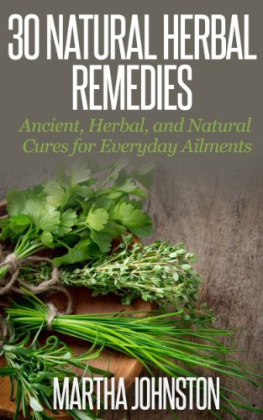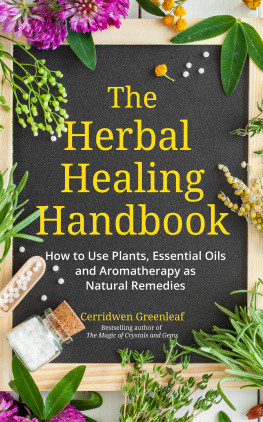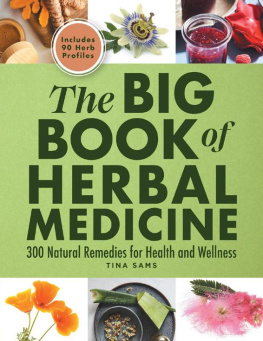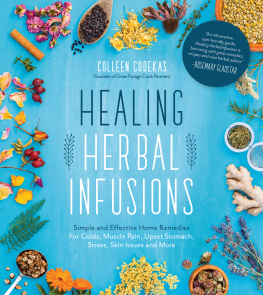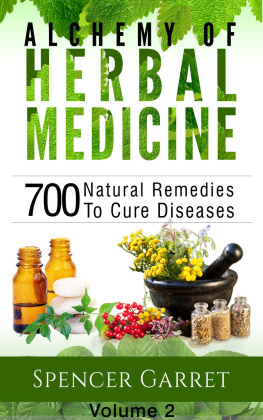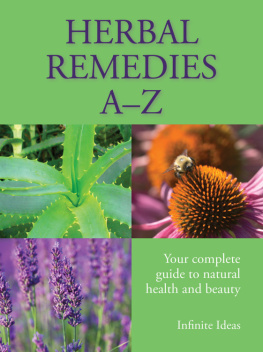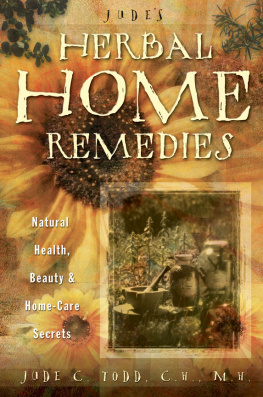Natural & Herbal Family Remedies
Cynthia Black
CONTENTS
Healing Soups
Vinegar Tonics
Healing with Yogurt
Homemade Fruit or Vegetable Flour
Simmer Pot Recipes
Aromatic Sachets
Introduction
Before the days of supermarkets stocked with mounds of produce, shelves of manufactured cosmetics, and aisles of pharmeceutical drugs, it was important to know how to care for yourself and your household with common items from everyday life. Our families learned to use natural and herbal ingredients that were readily available and easy to apply for all sorts of purposes among them beauty aids, health remedies, and household helpers. The recipes that my family created have been passed down through the generations. To this day, my family uses natural and herbal ingredients to create traditional remedies for all aspects of our everyday living. Your friends and family will appreciate these tried-and-true remedies that come from the heart and carry on traditions begun so long ago.
When youre working with herbs and other natural ingredients, its important to pay close attention to the recipe instructions. More is not always better 5 teaspoons of an herb in a hot-oil infusion will not necessarily work better than 2 teaspoons, and may in fact be harmful to your skin. Remember, the proportions called for in each recipe have been tested over time for best efficacy, so prepare the recipes as directed. In addition, use the recipes as directed a remedy that is effective when applied externally may be toxic if taken internally.
Equipment
These recipes require only common utensils that can usually be found in your kitchen. Heres a list of the basic equipment youll need:
Stainless steel, enamel, or glass pot or saucepan
Wooden spoon
Double boiler
Cheesecloth, colander, and/or press
Nonmetal containers with lids
Bottles of various sizes with caps
Definitions and Techniques
Before we begin, here are some definitions and instructions that will come in handy.
Creams. Herbal creams are easy to make. At your drugstore, buy a cream base that is hypoallergenic. Put this in the top of a double boiler and heat over boiling water, with the selected herbs, for 2 hours. (Unless otherwise directed, use about 1 ounce of dried herbs or 2 ounces of fresh herbs per 10 ounces of cream base.) Remove from heat, strain through a cheesecloth, and pack into jars. Seal tightly and keep in a cool, dark place.
Decoctions. The term decoction refers to the method of extraction from tough plant material such as roots or bark. To make a decoction, combine herbs and cold water in a saucepan. (Unless otherwise directed, use about 1 ounce of dried herbs or 2 ounces of fresh herbs per 2 cups of water.) Bring to a boil and simmer gently for 20 to 40 minutes (or until the liquid is reduced by about one-third). Then strain the liquid into a container and cover. Store in a cool place or refrigerate. Decoctions are best when freshly made.
Infusions. Making infusions with fresh or dried herbs is similar to making tea the herbs are steeped in liquid and then strained out. (Unless otherwise directed, use 1 tablespoon of fresh herbs or 2 teaspoons of dried herbs per cup of water.) To make a cold infusion, steep the herbs in cold water overnight in a sealed container. For a hot infusion, steep the herbs for 10 minutes in a covered container in hot water that has come down from a boil.
To make a cold-oil infusion, pack fresh herbs into a jar and add enough sunflower oil to cover them completely. Put a nonmetal lid on the jar (or a metal lid over a piece of plastic wrap stretched over the mouth of the jar) and place in the sun. Allow to steep for 3 to 4 weeks. Give the jar a gentle shake daily. Be sure that the herbs are completely immersed in the oil, or they can spoil. Strain and bottle. For a hot-oil infusion, combine fresh herbs and sunflower oil (or another unsaturated oil) in the top of a double boiler and heat over boiling water for 2 hours. (Unless otherwise directed, use 1 cup of fresh herbs per 2 cups of sunflower oil.) Do not allow the oil to boil. Strain the infused liquid through a piece of cheesecloth and store in bottles with tight-fitting lids in a cool, dark place.
Infused oils can be used for massage, bathing, cooking, or as the oil base of ointments.
Ointments. To make an ointment, melt unscented petroleum jelly in the top of a double boiler. Add the fresh herbs and cook for 3 hours. (Unless otherwise directed, use 1 cups of fresh herbs per 2 cups of petroleum jelly.) Keep an eye on the bottom pot of water during this long cook, as it may boil dry. Remove from heat, strain, and pour into jars. Seal tightly and store in a cool, dark place. A shortcut in making an ointment, if you have some herbal infused oil, is merely to thicken it with some warmed beeswax.
Poultices. To make a poultice, place ground herbs inside a double layer of a cotton or muslin pad. Moisten with a small amount of water and apply externally. Use a tie of some sort to keep the poultice in place.
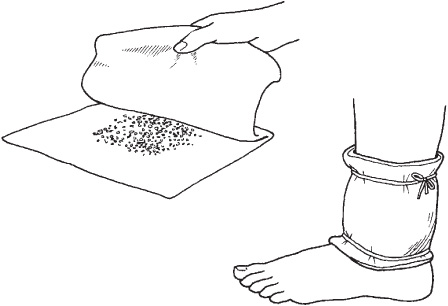
A poultice of ground herbs between two layers of a cotton or muslin pad can be tied in place where needed.
Tinctures. Tinctures are made by steeping herbs in a mixture of water and an alcohol such as vodka or gin (isopropyl alcohol, or rubbing alcohol, is extremely toxic do not use in making tinctures). The alcohol/water mixture is usually in a ratio of 25 percent alcohol to 75 percent water, or 1 part alcohol to 3 parts water. This ratio must take into account the water already present in the alcohol; for example, if you use a bottle of vodka that contains only 37.5 percent alcohol, or roughly one-third, you will have to add water in the amount of one-third of the total volume of the vodka so that you have a final proportion of 3 parts water per 1 part alcohol in the final mixture.
Combine the herbs and alcohol/water mixture in a large container. (Unless otherwise directed, use 7 ounces of dried herbs or 21 ounces of fresh herbs per 4 cups of the water/alcohol mixture.) Be sure that the herbs are totally immersed in the liquid, or they may spoil. Cover and store in a cool place for 2 to 3 weeks, shaking occasionally. Then strain the mixture (for a more potent tincture, use a wine or cider press to press the herbs) and store in dark glass bottles. Tinctures will keep for up to two years.
Warning: Because of the alcohol content, tinctures should not be taken internally by pregnant or lactating women, children, or recovering alcoholics. Tinctures can be toxic if taken in excess; most remedies call for just 1 or 2 drops. Be sure to research the correct and safe dosage!
Recipes for Health and Healing
Natural and herbal healing has become a popular alternative to what we often consider traditional medicine doctors, hospitals, and pharmaceutical drugs. Healing remedies that were once considered folklore have gained stature within the medical community as the natural healing properties of their ingredients are tested and approved. For further information about the growing use of herbs and natural ingredients for their healing properties, consult the great wealth of literature about homeopathy and natural healing.
Converting Recipe Measurements to Metric
Use the following formulas for converting U.S. measurements to metric. Since the conversions are not exact, its important to convert the measurements for all of the ingredients to maintain the same proportions as the original recipe.



